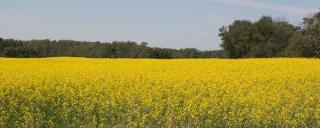
Cropland for Habitat
The Game and Fish Department can cost-share on management of cropland to benefit wildlife and soil health, as well as pay an access payment to these acres. Access for walk-in hunting is required on most cost-share agreements. The PLOTS programs for cost-share on cropland practices include Habitat Plots, Wildlife Food Plots, and the Working Lands programs.
Cropland Introduction
No bird or animal species solely depend on cropland for survival, or as a requirement to complete their life cycle. However, some species can benefit from cropland. These benefits will vary depending on the season, species and type of crop, mechanical disturbances and availability of food, water and cover.
Many bird species use cropland during portions of their annual life cycle. Migratory waterfowl and songbirds feed on weed seeds, waste and volunteer grain during spring and fall migration. Overwintering birds, such as sharp-tailed grouse, use cropland as a winter food source and for food and cover during the breeding season. Only a few bird species, such as killdeer and horned larks, prefer bare cropland fields for nesting. Some birds will nest in cropland after the crop has been planted. Exposure to predation and chemical applications is a concern. Nests and young are vulnerable if harvesting or other mechanical disturbances occur during the nesting and brood-rearing season. Winter cereal crops are attractive to some nesting birds because of early green-up and fewer disturbances in spring.
White-tailed deer, elk, moose and pronghorn are attracted to cropland for food. Mature or taller crops such as sunflowers, corn or wheat can also provide cover. Pronghorn use grains, weeds and crop residues as a replacement or substitute for their preferred foods of sage and coarse forbs. Small and medium-sized mammals also use cropland as cover and as a source of food. Many small mammal species eat crop seeds or plants when available. Medium-sized predators, such as red fox, striped skunk and raccoon hunt for birds, nests, rodents and insects in cropland, and occasionally feed on grains.
Restoration of Cropland
In prairie regions, cropland can be restored by returning it to perennial vegetative cover. An appropriate mix of native grasses and forbs can be established. A combination of grasses and forbs will provide nesting cover, brood-rearing habitat and foods for many species, including nesting waterfowl, upland game birds and many other grassland birds. Agricultural areas that were formerly wetlands can be restored by removing sediments, plugging drains and reestablishing native wetland plants.
Many species of waterfowl and some shorebirds require upland grasslands for nesting, but also need wetland habitats for foraging and raising young. Pheasants and sharp-tailed grouse nest in grasslands and often roost in tall emergent wetland vegetation, especially during winter.
Managing Cropland
Wildlife habitat on cropland can be improved by using various techniques:
- Avoid fall tillage. Adopt no-tillage or minimum tillage practices, leaving weed seeds and waste grain on or near the surface as food sources for wildlife. Avoid mechanical activities and heavy pesticide use in spring. Inversion tillage destroys foods, cover and nests, and opens fields to erosion.
- Provide food on conventional crop fields by leaving several rows or strips of standing crops adjacent to permanent winter cover.
- In landscapes that are intensively farmed, provide nearby alternative nesting and roosting habitat, such as planted cover (i.e., CRP and other set-aside grasslands) and wetlands. Include undisturbed or low-disturbance areas in the landscape to balance out more intensively managed areas.
- Provide properly distributed food plots for wildlife. Food plots should be properly distributed across the landscape to prevent unnatural concentrations of wildlife, which may lead to starvation, disease outbreaks or competition with domestic livestock food supplies. Food plots should be in blocks to minimize impacts of drifting snow.
- Avoid heavy herbicide and insecticide use that destroys many valuable food sources used by wildlife. Excessive or improper pesticide use will not only kill target weeds or insects, but also kill nontarget plants and insects in crop fields and adjoining areas.
- Proper crop rotations can also improve soil health and provide plant and insect diversity. Include grasses and legumes in the rotation, especially hayland that will not be disturbed until after the nesting season, preferably after August 1.
- Include direct-seeded winter crops in the rotation. These crops provide early spring green growth for nesting habitat and foods left from the previous crop.
- Choose crops such as sunflowers, corn, peas and winter wheat, which attract a broad spectrum of wildlife. Be aware that Genetically Modified Organism crops might reduce wildlife benefits due to fewer weed seeds and insects. Managing crop residues can be beneficial to resident wildlife. Tall stubble can provide habitat for ring-necked pheasants. Tall stubble also provides food and thermal cover. Depending on snowfall amounts, the benefits could last throughout the winter. Combines equipped with stripper headers, which leave stubble height greater than 12 to 15 inches, provide the most benefit to pheasants.
- Cover crops can provide wildlife food and cover. Taller crops provide the obvious escape and thermal cover. Cover crop seed mixes used to improve soil health provide high protein forage for grazers and browsers. The diversity of plants used in mixes also adds to insect diversity for young birds.
- Cover crop mixes, which include many of the brassica species or soybeans, field pea, corn, sunflower, millet and sorghum, left standing to maturity will provide quality seed for winter food.
